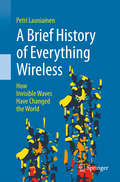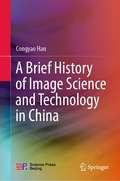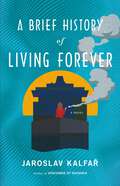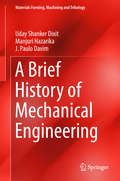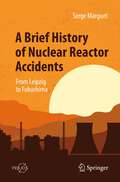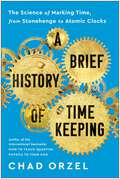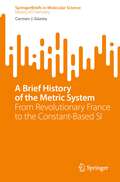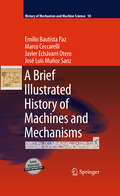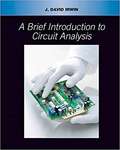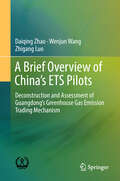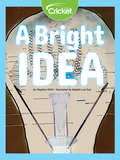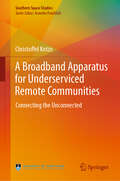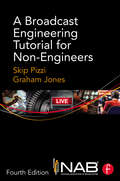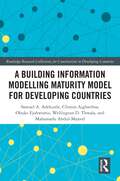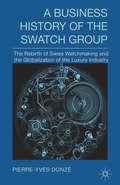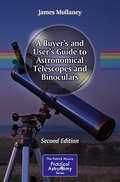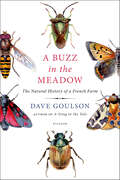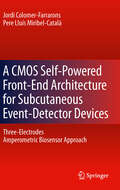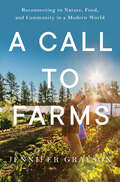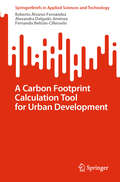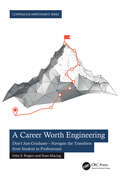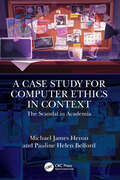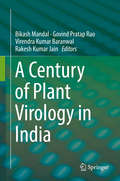- Table View
- List View
A Brief History of Everything Wireless: How Invisible Waves Have Changed the World
by Petri LauniainenSince the discovery of electromagnetic waves less than 150 years ago, the application of wireless communications technology has not only revolutionized our daily lives, but also fundamentally changed the course of world history.A Brief History of Everything Wireless charts the fascinating story of wireless communications. The book leads the reader on an intriguing journey of personal triumphs and stinging defeats, relating the prominent events, individuals and companies involved in each progressive leap in technology, with a particular focus on the phenomenal impact of each new invention on society. Beginning at the early days of spark-gap transmitters, this tale touches on the emergence of radio and television broadcasting, as well as radio navigation and radar, before moving on to the rise of satellite, near-field and light-based communications. Finally, the development of wireless home networks and the explosive growth of modern cellular technologies are revealed, complete with a captivating account of their corresponding company histories and behind-the-scenes battles over standards.For those wishing to peek behind the magic curtain of friendly user interfaces and clever engineering, and delve further into various processes underlying the ubiquitous technology we depend upon yet take for granted, the book also contains special “TechTalk” chapters that explain the theoretical basics in an intuitive way.
A Brief History of High-Speed Rail
by Qizhou Hu Siyuan QuThis book introduces the basic knowledge, concepts, terms and development process of high-speed rail (HSR) and summarizes its main achievements at this stage. It mainly expounds the connotation of high-speed rail to readers from two different aspects of theory and technology. The book explains the development process of high-speed rail in terms of time: yesterday's wheel rail high-speed rail, today's maglev high-speed rail and tomorrow's super high-speed rail; and also spatially, making a comparative analysis of the development around the world.This book can be used as a reading material for scientific researchers, engineering technicians, management workers, teachers and students of colleges and universities as well as high-speed railfans.
A Brief History of Image Science and Technology in China
by Congyao HanThis book, within the vision of the study on the image history, clearly manifests the development of Chinese image science and technology of over 2000 years based on compendium, while having briefly sorted out expositions by scientists since ancient times in China, demonstrates the spiritual course, ideas of thinking and forms of life and reveales profound humane ideas, basis of sentiments and styles of the spirit featured by Chinese image culture. The historic outline of images is clear-cut along with authenticated inter-attestation for clues of images and texts. Historic facts concerning images are ecologically diversified, while historic documents about images are properly chosen, in addition to the integration between liberal arts and science and perfect combination between images and texts. Blessed with nice integration between images and texts, this book serves as reference to experts, scholars, undergraduates and postgraduates related to the study on image history, history of science and technology, study of history and news communication.
A Brief History of Living Forever: A Novel
by Jaroslav KalfarIn this &“ingenious, funny, and chilling&” novel (Publishers Weekly, starred review) from the author of Spaceman of Bohemia, two long-lost siblings risk everything to save their mother from oblivion in an authoritarian near-future America obsessed with digital consciousness and eternal life—a story that &“packs a walloping punch&” (Esquire). When Adéla discovers she has a terminal illness, she leaves behind her native Czech village for a chance at reuniting in America with Tereza, the daughter she gave up at birth, decades earlier. But the country Adéla experienced as a young woman, when she eloped with a filmmaker and starred in his cult sci-fi movie, has changed entirely. In 2030, America is ruled by an authoritarian government increasingly closed off to the rest of the world. Tereza, the star researcher for VITA, a biotech company hellbent on discovering the key to immortality, is overjoyed to meet her mother, with whom she forms an instant, profound connection. But when their time together is cut short by shocking events, Tereza must uncover VITA&’s alarming activity in the wastelands of what was once Florida, and persuade the Czech brother she&’s never met to join her in this odds-defying adventure. Narrated from the beyond by Adéla&’s restless spirit, A Brief History of Living Forever is a high-wire act of storytelling from a writer &“booming with vitality and originality,&” whose &“voice is distinct enough to leave tread marks&” (New York Times). By turns insightful, moving, and funny, the novel not only confirms Jaroslav Kalfař&’s boundless powers of invention but also exults in the love between a mother and her daughter, which neither space nor time can sever.&“Kalfař is a wise, rapturous, and original writer . . . Eloquent, heart-stunning, and rich in awe-inspiring prose.&” —San Francisco Chronicle &“Relentlessly inventive . . . His writing has the same hyperactivity and fidgety contempt for generic boundaries as that of the young Safran Foer.&” —The Guardian
A Brief History of Mechanical Engineering (Materials Forming, Machining and Tribology)
by J. Paulo Davim Uday Shanker Dixit Manjuri HazarikaWhat is mechanical engineering? What a mechanical engineering does? How did the mechanical engineering change through ages? What is the future of mechanical engineering? This book answers these questions in a lucid manner. It also provides a brief chronological history of landmark events and answers questions such as: When was steam engine invented? Where was first CNC machine developed? When did the era of additive manufacturing start? When did the marriage of mechanical and electronics give birth to discipline of mechatronics? This book informs and create interest on mechanical engineering in the general public and particular in students. It also helps to sensitize the engineering fraternity about the historical aspects of engineering. At the same time, it provides a common sense knowledge of mechanical engineering in a handy manner.
A Brief History of Nuclear Reactor Accidents: From Leipzig to Fukushima (Springer Praxis Books)
by Serge MarguetAre you afraid of a nuclear reactor accident? Should you be? This book will arm you with the scientific knowledge necessary to make a rational and informed opinion on the subject, without having to be an expert in nuclear physics. Written so that a non-specialist can easily approach the highly technical aspects, it looks at all significant nuclear reactor accidents since the dawn of the Atomic Age and brings to light many crucial details that rarely, if ever, appear in the general media. Serge Marguet, an internationally renowned expert in reactor physics, breaks down the must-know technical aspects of numerous nuclear reactor accidents throughout history — both famous and unknown — from the first ever nuclear accident in Leipzig to the Chernobyl explosion and, finally, the Fukushima affair and its most recent developments. With many high-quality photographs and diagrams, this book is essential reading for anyone concerned about nuclear safety, curious about nuclear reactors, or simply interested in the history — and future — of nuclear power.
A Brief History of Timekeeping: The Science of Marking Time, from Stonehenge to Atomic Clocks
by Chad Orzel2022 NATIONAL INDIE EXCELLENCE AWARDS WINNER — HISTORY: GENERAL ". . . inherently interesting, unique, and highly recommended addition to personal, professional, community, college, and academic library Physics of Time & Scientific Measurement history collections, and supplemental curriculum studies lists.&” —Midwest Book Review "A wonderful look into understanding and recording time, Orzel&’s latest is appropriate for all readers who are curious about those ticks and tocks that mark nearly every aspect of our lives." —Booklist &“A thorough, enjoyable exploration of the history and science behind measuring time.&” —Foreword Reviews It&’s all a matter of time—literally. From the movements of the spheres to the slipperiness of relativity, the story of science unfolds through the fascinating history of humanity&’s efforts to keep time. Our modern lives are ruled by clocks and watches, smartphone apps and calendar programs. While our gadgets may be new, however, the drive to measure and master time is anything but—and in A Brief History of Timekeeping, Chad Orzel traces the path from Stonehenge to your smartphone. Predating written language and marching on through human history, the desire for ever-better timekeeping has spurred technological innovation and sparked theories that radically reshaped our understanding of the universe and our place in it. Orzel, a physicist and the bestselling author of Breakfast with Einstein and How to Teach Quantum Physics to Your Dog continues his tradition of demystifying thorny scientific concepts by using the clocks and calendars central to our everyday activities as a jumping-off point to explore the science underlying the ways we keep track of our time. Ancient solstice markers (which still work perfectly 5,000 years later) depend on the basic astrophysics of our solar system; mechanical clocks owe their development to Newtonian physics; and the ultra-precise atomic timekeeping that enables GPS hinges on the predictable oddities of quantum mechanics. Along the way, Orzel visits the delicate negotiations involved in Gregorian calendar reform, the intricate and entirely unique system employed by the Maya, and how the problem of synchronizing clocks at different locations ultimately required us to abandon the idea of time as an absolute and universal quantity. Sharp and engaging, A Brief History of Timekeeping is a story not just about the science of sundials, sandglasses, and mechanical clocks, but also the politics of calendars and time zones, the philosophy of measurement, and the nature of space and time itself. For those interested in science, technology, or history, or anyone who&’s ever wondered about the instruments that divide our days into moments: the time you spend reading this book may fly, and it is certain to be well spent.
A Brief History of the Metric System: From Revolutionary France to the Constant-Based SI (SpringerBriefs in Molecular Science)
by Carmen J. GiuntaThis book succinctly traces the history of the metric system from early modern proposals of decimal measures, to the birth of the system in Revolutionary France, through its formal international adoption under the supervision of an international General Committee of Weights and Measures (CGPM), to its later expansion into the International System of Units (SI), currently formulated entirely in terms of physical constants. The wide range of human activities that employ weights and measures, from practical commerce to esoteric science, influenced both the development and the diffusion of the metric system. The roles of constants of nature in the formulation of the 18th-century metric system and in the 21st-century reformulation of the SI are described. Finally, the status of the system in the United States, the last major holdout against its everyday use, is also discussed.
A Brief Illustrated History of Machines and Mechanisms (History of Mechanism and Machine Science #10)
by Marco Ceccarelli Emilio Bautista Paz Javier Echávarri Otero José Luis Muñoz SanzThis work deals with mechanical manufacturing processes in history, examined through the machines associated with those processes. A tool is only included if it is part of a machine tool, with devices made up of moving parts. Once the analytical field has been marked out, the chosen descriptive method is basically graphic. This historical compendium attempts to give a wide-angle view of historical development without making an in-depth analysis of each of the examples presented. Moreover, this book illustrates the historical development of machines and mechanisms more from a technical point of view rather than a strictly history of science point of view since the authors are mechanical engineers who are interested and motivated to examine the most significant facts in their own area of knowledge of the Theory of Machines and Mechanisms. A full understanding of the historical development of Technology also needs the help of experts in technical matters who can appreciate and reassess bygone achievements in the light of their own technical knowledge. More collaboration between science historians and technical experts is needed, as is currently the case in the field of Industrial Archaeology. Thus, this book is also an attempt to set out a technical approach to the historical development of machines and mechanisms, but without too many technical details that will prevent its understanding being purely historical. At the beginning of each chapter there is a global reference to the period embraced, the most relevant facts, and the most significant treatises in the context of machine history. Following this introduction each chapter contains a series of sections on the types of machines that are representative of the period analysed together with illustrations to accompany the text. A fairly extensive bibliography enables the reader to make a deeper historical analysis.
A Brief Introduction to Circuit Analysis
by J. David IrwinA Brief Introduction to Circuit Analysis.
A Brief Overview of China’s ETS Pilots: Deconstruction And Assessment Of Guangdong's Greenhouse Gas Emission Trading Mechanism
by Daiqing Zhao Wenjun Wang Zhigang LuoThis book systematically introduces readers to the framework of China’s ETS pilots, exploring their design and operating process, the current state of the carbon market, and various barriers encountered. To do so, it deconstructs the Guangdong ETS, which is the largest and most representative of China’s seven ETS pilots. The book subsequently describes and evaluates all seven pilots in terms of their efficiency, macro and micro effects, the method involved in the DEA model, the CGE model, and cost-benefit analysis. In turn, in the assessment section it demonstrates how some ETS pilots have failed to control carbon emissions due to inordinately high emissions quotas issued by the local government etc. Further, it argues that ETS should focus on those industries with large emissions and high mitigating potential for the time being, and then gradually expand the scale of its coverage.As China’s national ETS is slated for launch on the basis of the lessons learned from the ETS pilots, the book offers a timely and valuable resource for all those who want to understand and forecast the development of China’s ETS. It includes a wealth of descriptions and explanations of Chinese government policies involving carbon emissions control, making it a unique resource.
A Bright Idea
by Stephen WhittWhat does a light bulb require to burn bright? What happens when a light bulb burns out? Discover how filament, made of one of the heaviest metals, a mixture of two gases, a 60-watt light bulb, and electric currents make this bright idea more than just a bright light! The amazing science behind the light bulb awaits you!
A Bright Idea (Fountas & Pinnell Classroom, Guided Reading Grade 5)
by Nicole WalkerA Flash of Brilliance Most major inventions have been relatively high tech. The telephone, the printing press, the internal combustion engine—all rely on the interplay of many moving parts. Recently, however, a man designed an innovative solution to a global problem using nothing but a piece of trash: a discarded plastic bottle. NIMAC-sourced textbook
A Broadband Apparatus for Underserviced Remote Communities: Connecting the Unconnected (Southern Space Studies)
by Christoffel KotzeThis book investigates how broadband internet can be provided to remote and isolated communities through the use of satellite and other enabling technologies, in the form of a self-contained broadband apparatus. It discusses how the proposed design can help bridge the digital divide by removing one of the main hurdles to adopting technologies: infrastructure. In turn, the book explores how the lack of infrastructure, especially with regard to connectivity and electricity, can be addressed by exploiting new technological advances in a number of fields, notably the newly proposed large broadband satellite constellations. In closing, it uses concrete examples to demonstrate the potential positive impacts of a “broadband ecosystem” on economics, governance and society, and on achieving the United Nations’ Sustainable Development Goals.
A Broadcast Engineering Tutorial for Non-Engineers
by Graham Jones Skip PizziA Broadcast Engineering Tutorial for Non-Engineers is the leading publication on the basics of broadcast technology. Whether you are new to the industry or do not have an engineering background, this book will give you a comprehensive primer of television, radio, and digital media relating to broadcast—it is your guide to understanding the technical world of radio and television broadcast engineering. It covers all the important topics such as DTV, IBOC, HD, standards, video servers, editing, electronic newsrooms, and more. This long-awaited fourth edition includes new standards and identifies and explains the emerging digital technologies that are revolutionizing the industry, including: HDTV—and "UltraHD" IP-based production and distribution and Internet delivery (including "over-the-top" TV) Connected/Smart TV, Mobile TV Second Screens and Social TV "Hybrid" broadcasting (over-the-air and online convergence) Podcasting and Mobile Apps Connected Cars
A Building Information Modelling Maturity Model for Developing Countries (Routledge Research Collections for Construction in Developing Countries)
by Clinton Ohis Aigbavboa Wellington Didibhuku Thwala Abdul-Majeed Mahamadu Samuel Adekunle Obuks EjohwomuThis book provides a reference point for the development of Building Information Modelling (BIM) maturity in the developing country context. Developing countries have been observed to have low BIM maturity and are struggling to adopt the technology amidst no clearly defined pathways for achieving BIM capability maturity. The research presented in this book provides construction industry stakeholders in developing countries with a framework and nomological map to aid in the advancement of BIM implementation. This work provides a pathway for overcoming the challenges inhibiting BIM maturity in developing countries and ultimately its diffusion in order to harness the benefits. The authors provide critical theoretical insights on BIM maturity in the developing country context, a comparative analysis of BIM maturity in both developing and developed countries, and finally, a conceptualisation of BIM maturity for developing countries. The book is unique as its construct is rooted in the state-of-the-art information management standards in the digitalisation era in the construction industry (ISO 19650). The book delivers a theoretical reference point to the academic and research community and for the industry stakeholder, an essential guide to achieving BIM maturity at macro and micro levels.
A Business History of the Swatch Group: The Rebirth of Swiss Watchmaking and the Globalization of the Luxury Industry
by Pierre-Yves DonzéThis book offers a detailed and full analysis of the strategy which enabled the Swatch Group to establish itself on the world market. In particular, it tackles the issues of production restructuring, with the opening of subsidiaries in Asia, and the implementation of a new marketing strategy, characterized by the move towards luxury.
A Buyer's and User's Guide to Astronomical Telescopes and Binoculars (The Patrick Moore Practical Astronomy Series)
by James MullaneyAmateur astronomers of all skill levels are always contemplating their next telescope, and this book points the way to the most suitable instruments. Similarly, those who are buying their first telescopes - and these days not necessarily a low-cost one - will be able to compare and contrast different types and manufacturers. This exciting and revised new guide provides an extensive overview of binoculars and telescopes. It includes detailed up-to-date information on sources, selection and use of virtually every major type, brand, and model on today's market, a truly invaluable treasure-trove of information and helpful advice for all amateur astronomers. Originally written in 2006, much of the first edition is inevitably now out of date, as equipment advances and manufacturers come and go. This second edition not only updates all the existing sections of "A Buyer's and User's Guide to Astronomical Telescopes and Binoculars" but adds two new ones: Astro-imaging and Professional-Amateur collaboration. Thanks to the rapid and amazing developments that have been made in digital cameras - not those specialist cool-chip astronomical cameras, not even DSLRs, but regular general-purpose vacation cameras - it is easily possible to image all sorts of astronomical objects and fields. Technical developments, including the Internet, have also made it possible for amateur astronomers to make a real contribution to science by working with professionals. Selecting the right device for a variety of purposes can be an overwhelming task in a market crowded with observing options, but this comprehensive guide clarifies the process. Anyone planning to purchase binoculars or telescopes for astronomy - whether as a first instrument or as an upgrade to the next level - will find this book a treasure-trove of information and advice. It also supplies the reader with many useful hints and tips on using astronomical telescopes or binoculars to get the best possible results from your purchase.
A Buzz in the Meadow: The Natural History of a French Farm
by Dave GoulsonA CONSERVATIONIST'S DEEPLY PERSONAL AND FASCINATING REFLECTION ON OWNING AND REVITALIZING A FARM IN RURAL FRANCEA Sting in the Tale, Dave Goulson's account of a lifetime studying bees, was a powerful call to arms for nature lovers everywhere. Brilliantly reviewed, it was shortlisted for the Samuel Johnson Prize for the best nonfiction book of the year, and debuted the already renowned conservationist's ability to charm and educate, and tell an absorbing story. In A Buzz in the Meadow, Goulson returns to tell the tale of how he bought a derelict farm in the heart of rural France. Over the course of a decade, on thirty-three acres of meadow, he created a place for his beloved bumblebees to thrive. But other creatures live there too, myriad insects of every kind, many of which Goulson had studied before in his career as a biologist. You'll learn how a deathwatch beetle finds its mate, why butterflies have spots on their wings, and see how a real scientist actually conducts his experiments. But this book is also a wake-up call, urging us to cherish and protect life in all its forms. Goulson has that rare ability to persuade you to go out into your garden or local park and observe the natural world. The undiscovered glory that is life in all its forms is there to be discovered. And if we learn to value what we have, perhaps we will find a way to keep it.
A CMOS Self-Powered Front-End Architecture for Subcutaneous Event-Detector Devices: Three-Electrodes Amperometric Biosensor Approach
by Jordi Colomer-Farrarons Pere Lluís Miribel-CatalàA CMOS Self-Powered Front-End Architecture for Subcutaneous Event-Detector Devices presents the conception and prototype realization of a Self-Powered architecture for subcutaneous detector devices. The architecture is designed to work as a true/false (event detector) or threshold level alarm of some substances, ions, etc... that are detected through a three-electrodes amperometric BioSensor approach. The device is envisaged as a Low-Power subcutaneous implantable application powered by an inductive link, one emitter antenna at the external side of the skin and the receiver antenna under the skin. The sensor is controlled with a Potentiostat circuit and then, a post-processing unit detects the desired levels and activates the transmission via a backscattering method by the inductive link. All the instrumentation, except the power module, is implemented in the so called BioChip. Following the idea of the powering link to harvest energy of the magnetic induced link at the implanted device, a Multi-Harvesting Power Chip (MHPC) has been also designed.
A Call to Farms: Reconnecting To Nature, Food, And Community In A Modern World
by Jennifer GraysonHope for the future lies with a new generation of regenerative farmers. Within a decade, nearly half of all American farmland will change hands as an older generation of farmers steps aside. In their place, a groundswell of new growers will face numerous challenges, including soil degradation, insufficient income, and investors devouring farmland at a staggering pace. These new farmers are embracing regenerative agriculture—the holistic approach to growing food that restores the soil and biodiversity—in the movement to reclaim our health and the planet’s. But can their efforts help reverse an epidemic of diet-related disease, food inequality, and even climate change? To answer that question and more, award-winning journalist Jennifer Grayson embedded herself in a groundbreaking farmer training program, then embarked on this investigative journey. The diverse array of farmers, graziers, and food activists whom she profiles here are working toward better, more sustainable foodways for all. From a one-acre market garden in Oregon to activists reviving food sovereignty in South Carolina, A Call to Farms tells the captivating story of these new agrarians finding hope and purpose in reconnecting to the land and striving to improve the future of American food.
A Carbon Footprint Calculation Tool for Urban Development (SpringerBriefs in Applied Sciences and Technology)
by Roberto Álvarez-Fernández Alexandra Delgado-Jiménez Fernando Beltrán-CillerueloThis book introduces an indispensable tool: the carbon footprint calculator for urban planning. In the face of the escalating climate crisis, urban planning finds itself at a critical juncture. By considering the evolution of urban planning and its connections to environmental issues, the book sheds light on the urgent need to reimagine city planning within a climate-conscious framework. This book presents a meticulous assessment of future uses and activities that generate greenhouse gas emissions, along with an examination of land use changes that impact the carbon-absorbing capacity of the soil. Mitigation strategies, such as leveraging renewable energy sources for self-generation, are explored and quantified whenever possible. Carbon Footprint Planning explains the essential activities that must be included in urban planning instrument applications for approval, emphasizing the significance of integrating ordinary or simplified strategic environmental assessment procedures. By doing so, potential environmental impacts, specifically in relation to climate change, are effectively evaluated and addressed. With the aid of the carbon footprint calculator, decision-makers will gain the ability to select the path of least carbon emissions from a range of alternatives, unveiling aspects that contribute to significant emissions during the early stages of urban development, such as master planning. In essence, this book equips urban planners and environmental enthusiasts alike with the tools and insights needed to navigate urban growth amidst the climate crisis, ensuring a sustainable and resilient future for our cities.
A Career Worth Engineering: Don't Just Graduate—Navigate the Transition from Student to Professional (Continuous Improvement Series)
by John S. Rogers Sean MaciagTransitioning from student to professional can be a challenging journey, but it doesn't have to be a daunting mystery. In A Career Worth Engineering: Don't Just Graduate—Navigate the Transition from Student to Profession, the authors draw from their own experiences and share valuable lessons learned in the foundational years of their careers.The authors offer practical steps and insights to empower readers to take control of their career paths. By sharing their experiences, they aim to help others navigate the challenges and uncertainties of transitioning from student to professional. This book is designed to accelerate career growth and help individuals achieve their full potential, goals, and confidence in the engineering field.This book is a guide for new engineering students, recent graduates searching for their first job, or professionals feeling stagnant in their careers.
A Case Study for Computer Ethics in Context: The Scandal in Academia
by Michael James Heron Pauline Helen BelfordAimed at addressing the difficulties associated with teaching often abstract elements of technical ethics, this book is an extended fictional case study into the complexities of technology and social structures in complex organizations. Within this case study, an accidental discovery reveals that the algorithms of Professor John Blackbriar are not quite what they were purported to be. Over the course of 14 newspaper articles, a nebula of professional malpractice and ethical compromise is revealed, ultimately destroying the career of a prominent, successful academic.The case study touches on many topics relevant to ethics and professional conduct in computer science, and on the social structures within which computer science functions. Themes range from the growing influence of generative AI to the difficulties in explaining complex technical processes to a general audience, also touching on the environmental consequences of blockchain technology and the disproportionate gender impacts of Coronavirus. Each new revelation in the case study unveils further layers of complexity and compromise, leading to new technical and social issues that need to be addressed.Directly aimed at making ethics in the digital age accessible through the use of real-world examples, this book appeals to computer science students at all levels of the educational system, as well as making an excellent accompaniment to lecturers and course convenors alike.
A Century of Plant Virology in India
by Bikash Mandal Govind Pratap Rao Virendra Kumar Baranwal Rakesh Kumar JainThe book is a compilation of research work carried out on plant viruses during past 100 years in India. Plant viruses are important constraints in Indian agriculture. Tropical and sub-tropical environments and intensive crop cultivation practices ideally favours perpetuation of numerous plant viruses and their vectors in India, which often cause wide spread crop losses. Of all the plant pathogens, studies of plant viruses have received a special attention as they are difficult to manage. A large body of literature has been published on the plant virus research from India during past 100 years; however the information is so far not available in one place. This book provides comprehensive information on the biology, molecular biology, epidemics, crop losses, diagnosis and management of viruses and viroids occurring in India. Description of properties of the viruses are provided in the chapters comprising of different genera such as Allexivirus, Begomovirus, Babuvirus, Badnavirus, Carlavirus, Carmovirus, Cucumovirus, Closterovirus, Ilavirus, Mandrivirus, Potyvirus, Tospovirus, Tungrovirus and Sobemovirus. Virus-vector research related to aphid, thrips and whitefly is discussed. The work on the management aspects of plant viral diseases has been described with reference to the conventional, antiviral and transgenic approaches. Further, the quarantine mechanism developed in India for the exclusion of viruses and vectors has also been included. The book also provides useful information about the capacity building on the research and education on Plant Virology in India. Overall, the book covers a wide range of accounts of research findings and innovations in Plant Virology in India during past 100 years. The book will be a resourceful reference to the students, scientists, agricultural professionals and policy makers.
